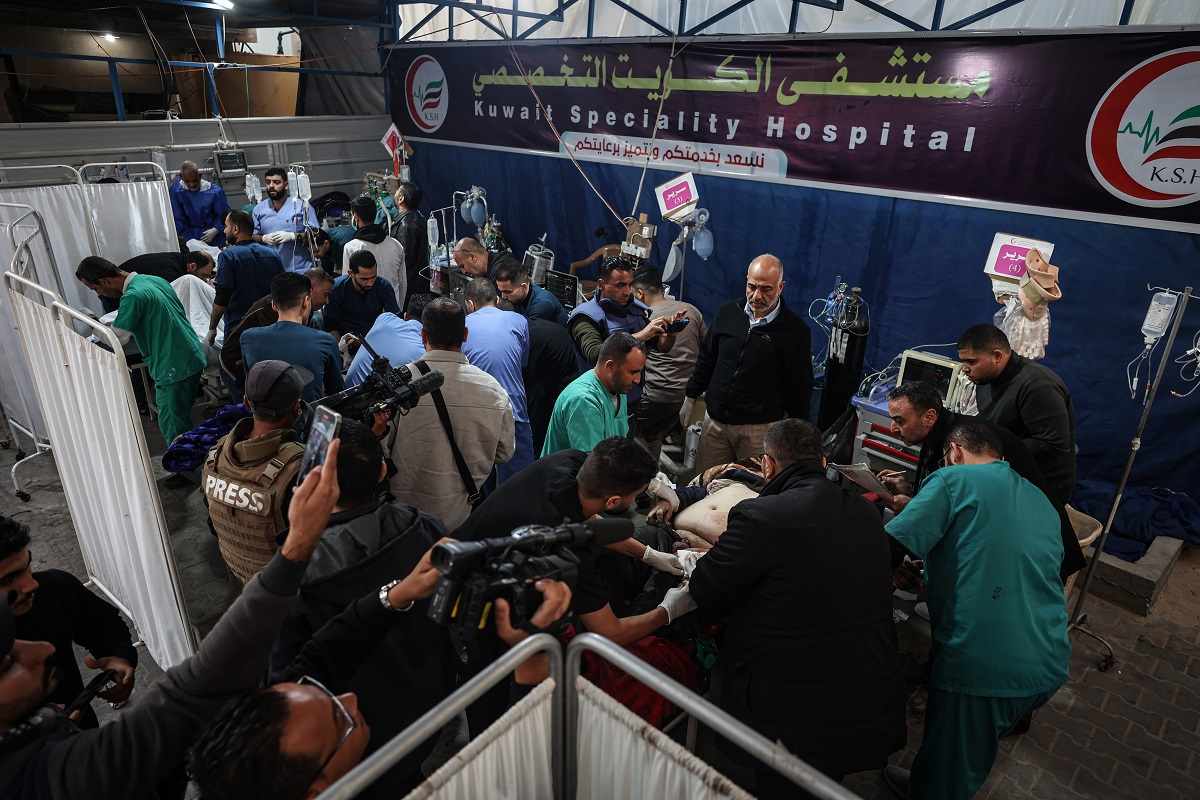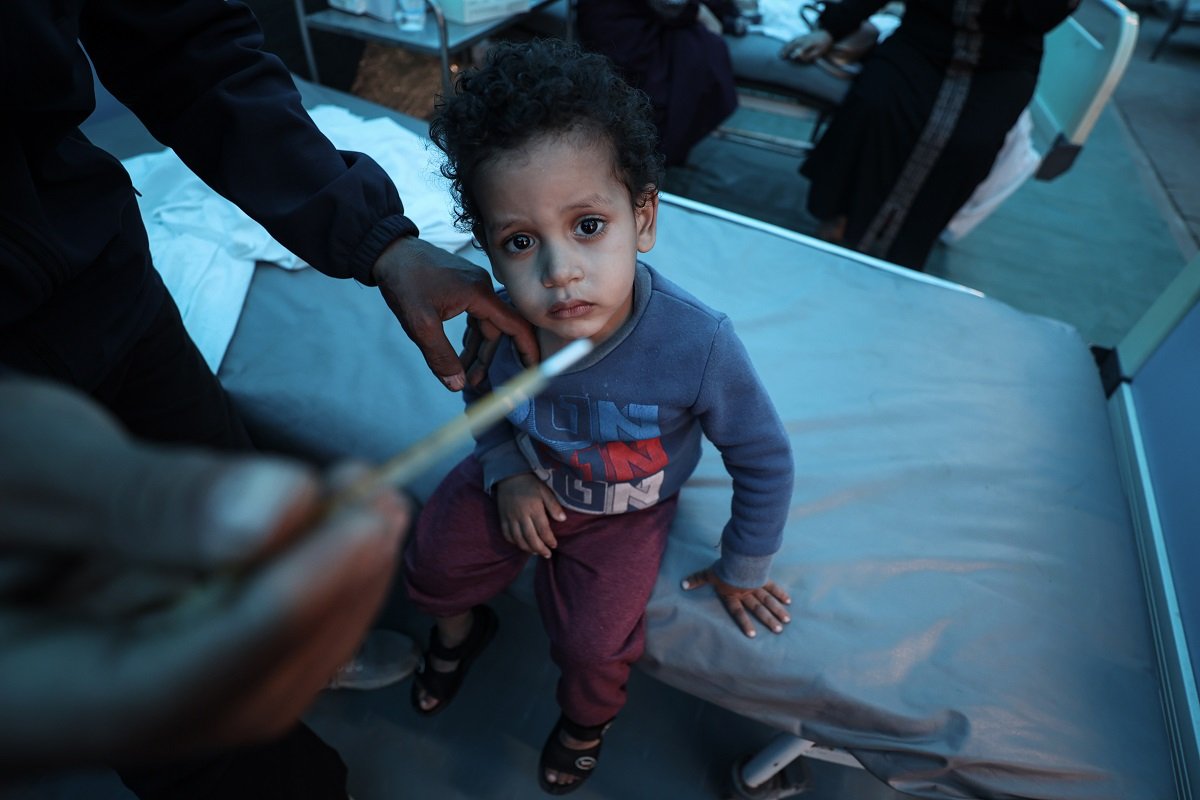
Medical personnel at Kuwaiti Hospital treat a rush of wounded people after a strike hit a house last week in central Rafah.
16:15 JST, December 18, 2023
JERUSALEM – Israeli strikes killed one of Tahani Abu Taima’s sons and one of her brothers, she says. But she fears a different killer is stalking what’s left of her family: disease.
The World Health Organization warns that Gaza’s health-care system is “collapsing” and that “worrying signals of epidemic diseases” are emerging.
Abu Taima’s 2-year-old daughter is suffering from diarrhea, vomits, sneezes and is “shaking from the cold and lack of food,” the mother of six told The Washington Post from the southern Gaza city of Khan Younis. The child “asks me for food all the time, but I am unable to provide,” Abu Taima said. “Which forces me to give her anything, even if it is contaminated.”
Abu Taima, 42, herself has thyroid cancer. But she has also developed a severe respiratory infection, she says, caused, she believes, by the pollution of war: dust and other particles that linger long after Israeli bombardments. Without electricity or fuel, she burns firewood when available to warm the family, “even though I am certain that the resulting smoke will kill me.”
She has been unable to get care. The family is sheltering in Nasser Hospital, but the overwhelmed facility is providing only limited treatment to the most severely wounded. Among patients and displaced people, crowded together without clean water or sanitation, infections spread rapidly. Abu Taima has no access to medicines.
“We are not alive,” she said. “We are dead and have living skeletons.”
After 10 weeks of Israel’s military campaign against Hamas, crowded, besieged, bombarded and famished Gaza is now fertile ground for disease.
Staph infections, chickenpox, rashes, urinary tract infections, meningitis, mumps, scabies, measles and food poisoning all are rising, the Gaza Health Ministry and individual doctors say. The WHO is particularly concerned about bloody diarrhea, jaundice and respiratory infections. The United Nations is tracking 14 diseases with “epidemic potential,” Reuters reported.
“The risk is expected to worsen with the deteriorating situation and approaching winter conditions,” the WHO said in a statement.
The conflict erupted when Hamas and allied gunmen streamed out of Gaza on Oct. 7 to attack Israeli communities. They killed 1,200 people and took 240 back to the enclave as hostages.
Israel responded with a military campaign aimed at eradicating Hamas. Israeli forces have killed about 18,800 people in the territory and wounded more than 50,000, according to the Gaza Health Ministry.
WHO Director General Tedros Adhanom Ghebreyesus said that this month, “health needs have increased dramatically, and the capacity of the health system has been reduced to one-third of what it was.”
Two-thirds of primary care centers are closed, the WHO says; 11 of Gaza’s 36 hospitals are partially functioning. The U.N. agency for Palestinian refugees is operating nine of its 28 primary health clinics. Nearly 85 percent of Gazans have been forced from their homes, and about 1.3 million people live in shelters where there is an average of one toilet for every 220 people and one shower for every 4,500.
There is particular concern about disease outbreaks in Rafah, where almost half of the enclave’s 2.2 million people are sheltering in homes, schools, camps and streets. Israel told Palestinians to go to the southern city for their safety.
Children have been hit hard. Cases of diarrhea in children jumped 66 percent from Nov. 29 to Dec. 10, and among the rest of the population, cases increased by 55 percent, according to WHO data assessed by Reuters.

A sick child is attended to last week at Kuwaiti Hospital in Rafah.
Naima al-Tatri and her children have moved four times since Oct. 7. The family now lives in a tent outside a school in Rafah.
“My children have digestive problems and vomit all the time, and I cannot find a way to treat them,” said Tatri, 37. “Hospitals are full. There are no services at all. No international organizations have visited us.”
“I wonder,” she said, “where is the world regarding our suffering?”
Hala Afshour, 16, is battling chickenpox, a respiratory illness, digestive problems and a urinary tract infection, on top of preexisting liver problems, she told The Post.
Five years ago, Afshour had surgery so she would no longer need dialysis. But since the war began, she said, she hasn’t been able to find the medications she takes. She and her six sisters moved twice around Gaza City before arriving last month in Rafah. They’re staying in a school crowded with fellow displaced people. Their father stayed behind to care for his blind elderly mother.
In Rafah, Afshour said, she and her sisters developed respiratory problems. Then “some strange bubbles began to appear on my body,” she said. A doctor told her it was chickenpox and gave her a lotion.
She is supposed to apply the lotion twice a day, but “there is no place for me to have my privacy.” She’s in constant pain, she said, and can’t sleep. Her clothes rub against the chickenpox papules. She has a headache, bone pain and fever. The urinary tract infection, she said, developed because she was “unable to use the bathroom regularly due to the large number of displaced people” and long lines in the school.
Even before the war, health-care needs in Gaza were acute. Many Gazans already suffered from complex health issues. Hospitals were hobbled by frequent power outages and shortages of medicine. Gazans with severe conditions were required to secure difficult-to-obtain Israeli permits to leave the enclave for treatment.
Fourteen-year-old Abdul Hamid Qadouha, had an appointment and permission to go to Israel to treat a head injury on Oct. 8, his father said. He never made it.
After the Hamas attack on Oct. 7, Israel sealed the enclave and launched airstrikes. A week into the war, Saif al-din Qadouha said, the family of 11 fled their home in Karama for the Nuseirat refugee camp in central Gaza.
Soon after their arrival, Qadouha said, his son became tired. He wasn’t hungry. He grew pale and his eyes yellowed. Viral hepatitis, a doctor told them.
After a strike nearby, the family fled to Rafah, where they live in a tent at a school. There’s no way to stay clean, Qadouha said. They get some water only every three or four days from the United Nations.
Qadouha is panicking as his son’s condition worsens. “I didn’t lose my children to missiles, but now I’m watching them die of disease,” he said.
Mohamed Madi, a physician, spent the first five weeks of the war at the Rantisi children’s cancer hospital in Gaza City. In November, Israel ordered the hospital to evacuate. Madi carried some patients out and left for Rafah.
He and his family live in a school housing about 2,000 people with no medical care. U.N.-run facilities typically have small clinics. But there are no such facilities in the government-run schools where thousands of Palestinians have settled.
Madi and some medical colleagues have started a small clinic in the school.
“We began dealing with cases specifically of people infected with chickenpox, scabies, intestinal infections and chest infections,” he said. “We received a number of cases infected with hepatitis A.”
Displaced Gazan doctors and nurses elsewhere have launched similar clinics. Israel has sharply cut the flow of medical aid into Gaza, but it has approved the entry of materials for field hospitals in the south funded by countries such as the United Arab Emirates.
“There are standing hospitals throughout Gaza that can and should be used, safely, without the risk of the bombardment, siege or deprivation of critical supplies including fuel, water and essential medicines,” said Tanya Haj-Hassan, a physician with Doctors Without Borders who has worked in Gaza.
Foreign-funded initiatives, she said, are only a Band-Aid for dealing with the spread of diseases.
"News Services" POPULAR ARTICLE
-

American Playwright Jeremy O. Harris Arrested in Japan on Alleged Drug Smuggling
-

Japan’s Nikkei Stock Average as JGB Yields, Yen Rise on Rate-Hike Bets
-

Japan’s Nikkei Stock Average Licks Wounds after Selloff Sparked by BOJ Hike Bets (UPDATE 1)
-

Japan’s Nikkei Stock Average Buoyed by Stable Yen; SoftBank’s Slide Caps Gains (UPDATE 1)
-

Japanese Bond Yields Zoom, Stocks Slide as Rate Hike Looms
JN ACCESS RANKING
-

Keidanren Chairman Yoshinobu Tsutsui Visits Kashiwazaki-Kariwa Nuclear Power Plant; Inspects New Emergency Safety System
-

Imports of Rare Earths from China Facing Delays, May Be Caused by Deterioration of Japan-China Relations
-

University of Tokyo Professor Discusses Japanese Economic Security in Interview Ahead of Forum
-

Japan Pulls out of Vietnam Nuclear Project, Complicating Hanoi’s Power Plans
-

Govt Aims to Expand NISA Program Lineup, Abolish Age Restriction



















